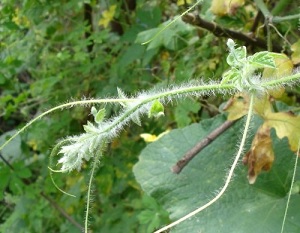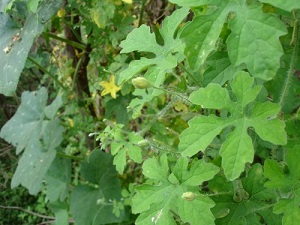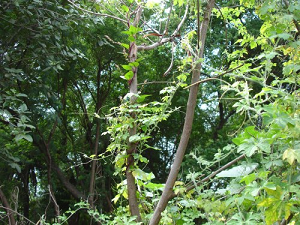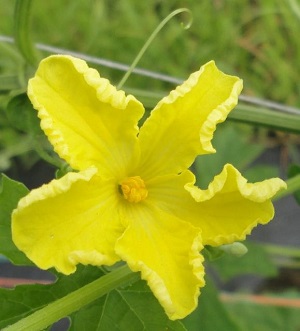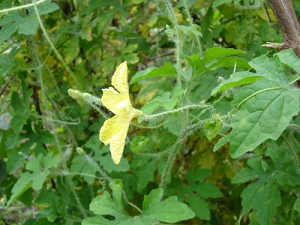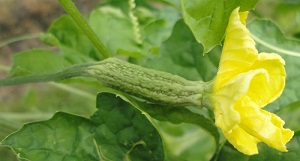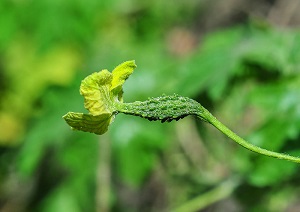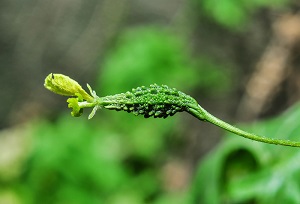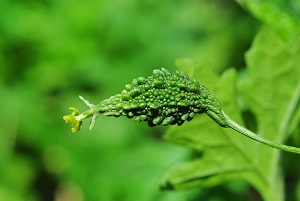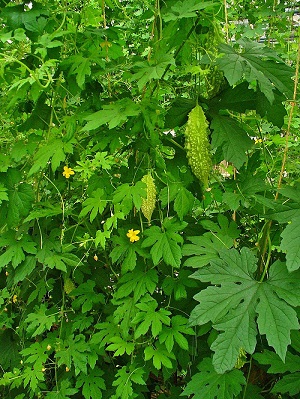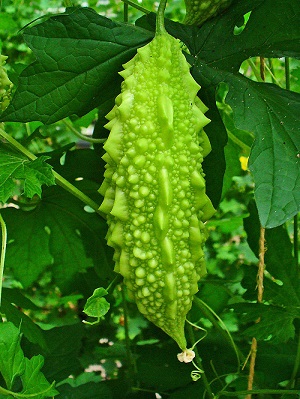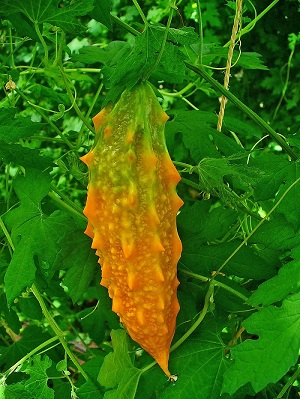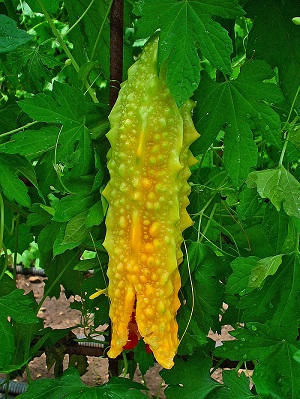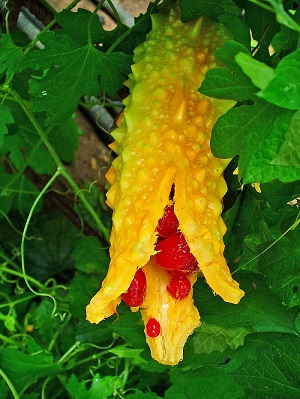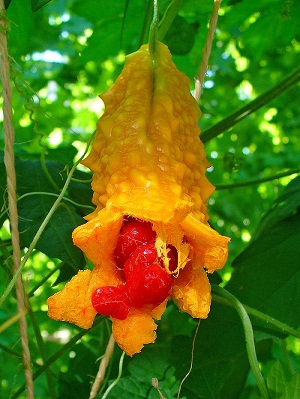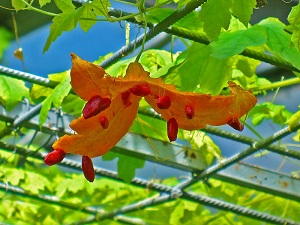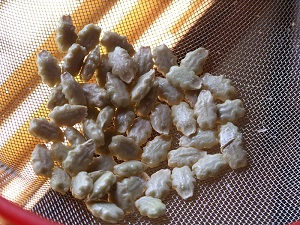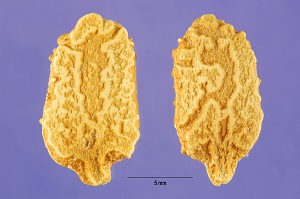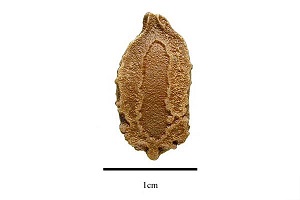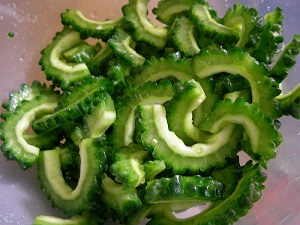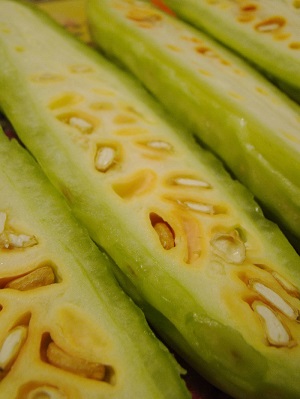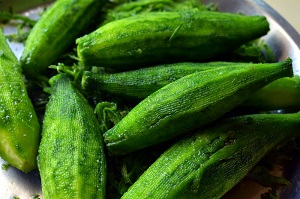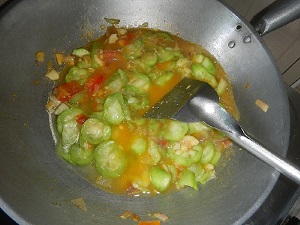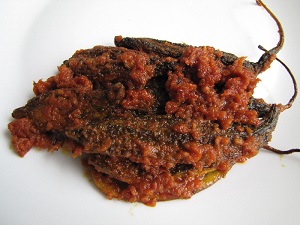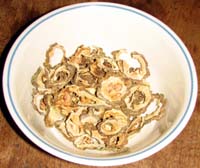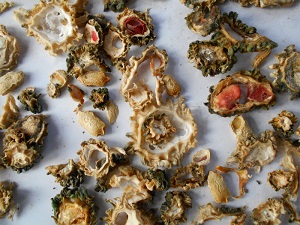| Bitter Melon - Momordica charantia | |||||||||||||||||||||||||||||||||||||||||||||||||||||||||||
|---|---|---|---|---|---|---|---|---|---|---|---|---|---|---|---|---|---|---|---|---|---|---|---|---|---|---|---|---|---|---|---|---|---|---|---|---|---|---|---|---|---|---|---|---|---|---|---|---|---|---|---|---|---|---|---|---|---|---|---|
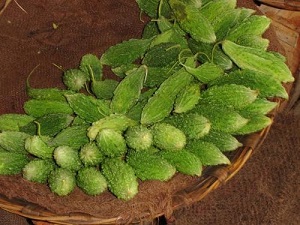 Fig. 1  M. charantia, Karela, at urban vegetable market in Chhattisgarh, India 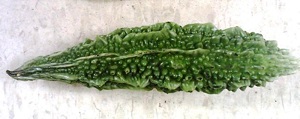 Fig. 2  Indian bitter melon, pointed ridges 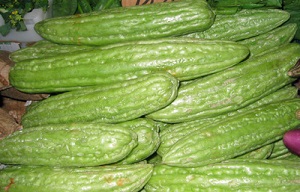 Fig. 3  Chinese bitter melon, smooth ridges, Khổ qua, mướp đắng, Khóo-kue. 苦瓜。 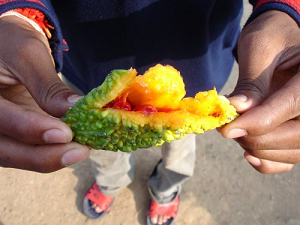 Fig. 4  M. charantia. Dashera mela at Rawan Bhata village, India, karela fruit  Fig. 5  Karela at flowering 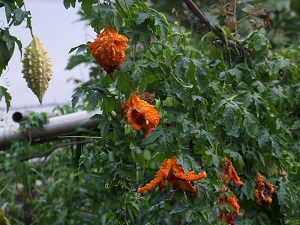 Fig. 6  M. charantia, bitter melon. Israel  Fig. 23  Dashera Mela at Rawan Bhata village, India. Local vegetables available. Taroi, Barbatti, Bhindi and Karela. M. charantia, Abelmoschus esculentus, Vigna unguiculata, luffa, raipur, mela 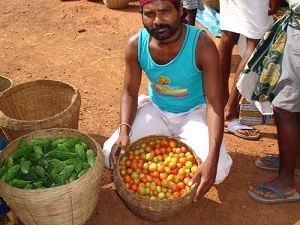 Fig. 24  M. charantia Village market, Nagarnar, Bastar, India  Fig 25  M. dioica, M. charantia. At weekly market in India 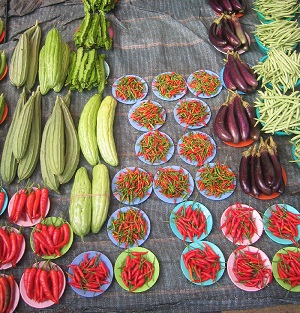 Fig 26  Organic vegetables at a farmers' market in Argentina  Fig. 27  Seeds from bitter melon (M. charantia), Thai variety 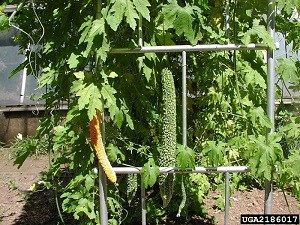 Fig. 31  M. charantia, balsam apple 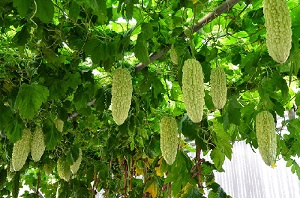 Fig. 32  Bitter melon droop under the shed  Fig. 33  M. charantia. Baramasi Karela in a home garden, India 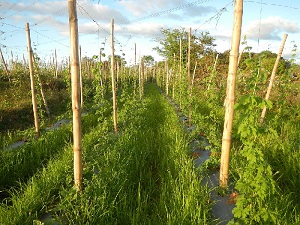 Fig. 34  Sunsets in Bulacan, Paddy fields of San Rafael, Bulacan Cattle and M. charantia in Barangay Pulo, San Rafael, Bulacan, Philippines 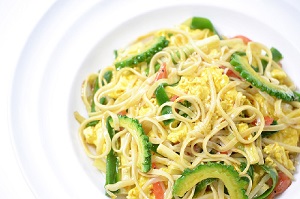 Fig. 35  Noodle, bitter melon |
Scientific
name Momordica charantia L. Pronunciation mo-MOR-dee-ka char-AN-tee-ah 7 Common names English: African cucumber, balsam apple, balsam pear, bitter gourd, bitter cucumber, bitter melon, carilla gourd; French: concombre africain, margose, momordique, paroka; German: amerikanische bittergurke, balsambirne, bittergurke; India: karela; Indonesian: paria; Malay: peria; Spanish: balsamito, bálsamo, cundeamor; Swedish: bittergurka; Transcribed Chinese: ku gua; Transcribed Korean: yeoju 1,10 Synonyms M. indica; M. elegans; M. chinensis; M. charantia subsp. abbreviata (Ser.) Greb.; M. charantia f. abbreviata (Ser.) W.J. de Wilde and Duyfjes; M. charantia var. abbreviata Ser.; M. charantia var. longirostrata Cogn.; var. M. charantiamuricata (Willd.) Chakrav; M. zeylanica Mill. 1,2,4 Relatives Balsam apple, M. balsamina L.; spiny gourd, M. cochinchinensis (Lour.) Spreng. Family Cucurbitaceae Origin Africa, Asia-tropical, Australasia, Pacific 1 USDA hardiness zones 8-10 15 Uses Leaves and young fruit as a vegetable; seeds as condiment; medicine 1,4 Life Form Herbaceous, tendril- bearing vine Physiology/habit Multi stem 4; climbing, scrambling Height Slender climber reaching 10 ft (3 m) or more 5 Leaf Simple; alternate toothed lobes (5-7) 4 Flower Yellow and about 0.75 in. (2 cm) in diameter 4 Fruit Oblong, 4-6 in. (10-15 cm) long 5 Crop cycle 50-70 days 4s Planting season September - February Seed germination temperature Warm 60-95 °F (16-35 °C) 8 USDA Nutrient Content: pods, leafy tips pdf Light requirement Clear, bright skies Photoperiod Short day (<12 hours); neutral day (12-14 hours) 4 Soil Medium to heavy; well drained; moderate fertility 4 pH preference Optimal: 6-6.5; absolute: 4.5-8 4 Cold tolerance Optimal: 72-86 °F (22-30 °C), absolute: 59-100 °F (15-38 °C), killed at 37 °F (3 °C) 4 Plant spacing 36-60 in. (91-150 cm), rows 60-72 in. (150-183 cm) 9 Planting Soil depth Optimal: 20-60 in. (50-150 cm); absolute: 8-20 in. (20-50 cm) 4 Invasive potential * Invasive in south Florida; caution in central and north Florida Pantropical (all-tropical areas): weed 4 Known hazard Poisonous to mammals 1 Reading Material Bitter Melon - an Asian Vegetable Emerging in Florida, University of Florida pdf Momordica - Momordica spp., University of Florida pdf Bitter Gourd, Balsam Pear: Pharmacy On A Fence, Eattheweeds.com Bittermelon. Cucurbit Production Chapter, Vegetable Production Handbook of Florida, University of Florida pdf Description It is a tropical and subtropical vegetable crop with long climbing vines which is widely cultivated in Asia, Africa, and the Caribbean. The fresh fruiting vegetable is one of the most popular vegetables grown in China, India, Thailand, the Philippines, and Vietnam. 8 A herbaceous, pubescent vine up to 5 m long climbing by tendrils with leaves, alternating, simple, cordate and much lobed. Bitter gourd is normally grown in hot, humid tropical areas with high rainfall at elevations up to 500 m. It grows wild in lowland rain forest and riverine forest, up to 1000 m in altitude. Bitter gourd is an invader of recently cleared, plateau soils in areas of high rainfall. It is generally kept under control by trampling and light grazing by cattle. In ungrazed situations balsam pear may become dominant, smothering out less aggressive species. 4 Bitter gourd is an important vegetable crop and widely cultivated in the tropics. 10
Fig. 7. Hairs on new bitter gourd vine, India Fig. 8. Typical shape of bitter gourd leaves, India Fig. 9. Karela growing with support, India Flowers Flowers are yellow and about 0.75 in. (2 cm) in diameter. Both male and female flowers grow on the same plant. 4 The vine flowers 30-35 days after planting. 3
Fig. 10. Bitter melon’s male flower Fig. 11. Back part of male flower Fig. 12. Bitter melon’s female flower Fruit The fruit is something like a cucumber, more spindle shape or globose with a very wart-like surface. Green when young, bright orange when ripe, fleshy but dehiscent. A lumpy appearance and when fully ripe burst open. It has bright red seeds inside. 4 There are two types of bitter melon: Indian and Chinese. The Indian type has smaller fruit with dark green color and rough skin, and the Chinese type has larger fruit with light green color and smooth skin. 9
Fig. 13. Two days old fruit with flower, West Bengal, India Fig. 14. Three days old fruit with flower, West Bengal, India Fig. 15. Ten days old fruit with flower, West Bengal, India Fig. 16. Habitus with flowers and fruits Fig. 17. Developing fruit Fig. 18. Ripe fruit Fig. 19. Beginning of bursting Fig. 20. Burst fruit Fig. 21. Oozing of seed Fig. 22. "Old" fruit Varieties Three members of the genus Momordica grow very well in Florida home gardens. These are Chinese cucumber (M. cochinchinensis), balsam pear (M. charantia) Fig. 2, 3), and balsam apple (M. balsamina). All these cucurbits are fruits of annual running vines with near-round, deeply notched leaves. 5 The cultivars for Bittermelon (Chinese) are Hong Kong Green, Hybrid Bangkok Large, Japan Green Sprindle, Taiwan Large, and for Bittermelon (Indian) are Hybrid India Star, India Green Queen, India Green Long and Palee. 9 Harvesting Fruits are ready for harvesting 50-70 days after planting and the plant continually bears fruit for the following 70-85 days. Yields of up to 10-30 t/ha can be obtained. 4 Pollination Bitter melon is a cross-pollinating species and needs insects, such as bees, to carry out the pollinating process for setting fruit. 8 Bees are essential for cucurbit production. It has been estimated that eight or more visits per blossom are necessary for optimum fruit set and normal fruit development in watermelon. The morning hours are most critical for pollination, but bees will continue to forage into the afternoon. 11 Propagation By seed with warmth at between 60-95 °F (16-35 °C) and moist soil. Germination is usually slow due to the thick and hard testae, and may fail or be very slow with lower temperatures and/or dry conditions. 8
Fig. 28. M. charantia, bitter melon, dried seeds Fig. 39,30. M. charantia seeds from Guyana collected by W. A. Archer
Planting Momordica production in Florida gardens should be similar to production of cucumbers. Allow 3 to 4 months from seeding to harvest. Provide ample space or a trellis for the vines that sometimes reach 10 feet or more in length. 5 Commercially Momordica vines are trellised (Fig. 31), primarily to maximize space and sufficient sunlight, minimize bud drop and fruit rot caused by over shading and exposure to soil moisture and pathogens and to promote straight fruit. These crops are started from seed and grown as transplants prior to being set in the field 9 Irrigation Asian cucurbits can be grown with drip, overhead or subsurface irrigation. 9 Diseases/Pests The most common diseases of bitter melon (M. charantia) in South Florida include: downy mildew, powdery mildew, Fusarium wilt, target leaf spot, and root-knot caused by nematodes. 14 Diseases of Bitter Melon in South Florida, University of Florida pdf Florida Plant Disease Management Guide: Cucumber, University of Florida pdf (Archived) Anthracnose on Cucurbits in Florida, University of Florida pdf Insect Management for Cucurbits (Cucumber, Squash, Cantaloupe, and Watermelon), University of Florida pdf Nematode Management in Cole Crops, University of Florida ext link Food Uses The fruit flesh is often used in Chinese cuisine with sliced garlic, chicken eggs, pork, or “douchi,” a type of fermented and salted black soybean. In Indian dishes, the sliced fruit is marinated in a solution of salt and tamarind before being pan-fried with spices. 8 The immature fruit is boiled as a vegetable, used in a similar manner as the egg shaped M. balsamina (balsam apple). 5 To remove most of its bitterness the whole small fruits or fruit slices are soaked in salt water before or after parboiled. They are cooked in many dishes, and can be pickled. Fruits are also stuffed. Leaves make a good spinach dish. Fruits, young shoots and flowers are used as flavouring. 4 Brighter green and younger are better. Older, yellowish ones are tough with fibrous cores. When young, the whole gourd is eaten, including pith and seeds. In older ones, scrape out seeds. Eaten raw, thinly sliced in salads or added to rich spicy curries to mellow bitterness. Stir-fried w/spices and lime juice, deep-fried into crunchy chips. Bengalis - soup, punjabis slit and stuff with spicy mashed potatoes or ground almonds and pan-fry. Pickled w/garlic and tamarind. Small, firm, shiny. Avoid overripe, soft yellowish (Fig. 37).
Fig. 36. Bitter gourd cleaned and sliced for cooking Fig. 37. From Bladhom: More jagged and narrower than Chinese variety of bitter melon. Fig. 38. Cut in half. Next, clean out seed, slice thin and salt. Cure 24-48 hours, rinse and drain VERY well. Fig. 39. Bitter melon peeled Fig. 40. M. charantia. Ampalaya fruits, flowers and seeds Tuna Mechado Cooking in Bulacan Ginisang Patola, Philippines Fig. 41. Punjabi-style stuffed bitter gourds cooked in tomato-based masala, which are typically eaten in summer Fig. 42. Dried Gohyah slices prepared for use as tea Fig. 43. Sliced pieces of partially dried bitter gourd (Momordica charantia) kept for sun drying. Dried ones are used for making a South Indian crispy dish called Kondattam/Vettal by frying in oil and is usually served along with rice and curry or it is used in curries or many other dishes, India Fig. 44. A drink made from bitter melon, with bitter melon man the superhero on it Medicinal Properties ** Karela (M. charantia), a promising traditional medicine for diabetes, at urban vegetable market in Chhattisgarh, India. (Fig. 1) Bitter gourd fruit contain bioactive components with many important medicinal properties (Horax et al. 2005). 10 Other Edibles in the Momordica genus: Balsam apple, M. balsamina Gac, Chinese cucumber, M. cochinchinensis General M. charantia. By visiting village Haat or market one can get much information about local life style, culture and food habits. In Indian State Chhattisgarh most of the village Haat or markets are weekly. These markets fulfill the requirement of villagers. In rural areas the markets are having local materials. The markets of tribal regions are unique in all sense. One can see the rare medicinal herbs, the sell of medicinal insects and traditional ornaments. (Fig. 24) 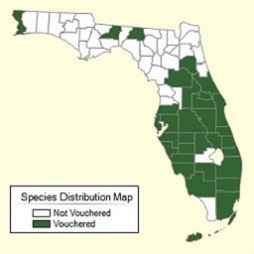 Fig. 45 Fig. 45. Florida Distribution Map of M. charantia Further Reading Bitter Gourd: Botany, Horticulture, Breeding, Horticultural Reviews pdf Suggested Cultural Practices for Bitter Gourd, Asian Vegetable Research and Development Center pdf Weed Management in Cucurbit Crops (Muskmelon, Cucumber, Squash, and Watermelon), University of Florida pdf Bitter Melon Botanical Art Older material Momordica charantia, 1979, Edible Leaves Of The Tropics Balsam apple, 1919, 1972 Sturtevant’s Edible Plants Of The World List of Growers and Vendors |
||||||||||||||||||||||||||||||||||||||||||||||||||||||||||
| Bibliography 1 "Taxon: Momordica charantia L." No. 24520. U.S., National Plant Germplasm System, www.ars-grin.gov/npgs/. Accessed 30 Nov. 2017. 2 "Momordica charantia L. synonyms." The Plant List (2013), Version 1.1., www.theplantlist.org/tpl1.1/search?q=Momordica+charantia. Accessed 18 July 2017. 3 Nath, Prem, “Bird bitter gourd (Momordica charantia L.)” The Vegetable Sector in Thailand, Food and Agriculture Organization of the United Nations, 1999, www.fao.org/docrep/004/ac145e/AC145E09.htm. Accessed 1 July 2017. 4 Labrada, Ricardo. “Momordica charantia L.” Ecocrop, Food and Agriculture Organization of the United Nations, 2014, ecocrop.fao.org/ecocrop/srv/en/cropView?id=7795. Accessed 1 July 2017. 5 Stephens, James M. "Momordica, Momordica spp." Horticultural Sciences Dept., UF/IFAS Extension, HS627, Original pub. May 1994, Revised Sept. 2015, AskIFAS, edis.ifas.ufl.edu/mv094. Accessed 1 July 2017. 6 "Cucurbitaceae Momordica charantia L." International Plant Names Index, 20 Jan. 2004, www.ipni.org/ipni/idPlantNameSearch.do?id=132255-3&back_page=&show_history=true. Accessed 1 July 2017. 7 Deane, Green. "Bitter Gourd, Balsam Pear: Pharmacy On A Fence." Eat The Weeds and other things, too. www.eattheweeds.com/bitter-gourd-balsam-pear-pharmacy-on-a-fence/. Accessed 1 July 2017. 8 Liu, Guodong. "Bitter Melon—an Asian Vegetable Emerging in Florida." Horticultural Sciences Dept., UF/IFAS Extension, HS1271, Original pub. Dec. 2015, Revised Apr. 2019 and June 2022, AskIFAS, edis.ifas.ufl.edu/hs1271. Accessed 17 July 2017, 23 Dec. 2023. 9 Freeman, Josh H. "Chapter 7. Cucurbit Production, Vegetable Production Handbook of Florida, 2017–2018 edition." Twenty-first edition of Vegetable Production Handbook for Florida, University of Florida Institute of Food and Agricultural Sciences, edis.ifas.ufl.edu/pdffiles/cv/cv29200.pdf. Accessed 29 Nov. 2017. 10 Behera T. K. "Bitter Gourd: Botany, Horticulture, Breeding. 2010." Horticultural Reviews, Volume 37. pp 124 -129, 131-132. handle.nal.usda.gov/10113/42264. Accessed 30 Nov. 2017. 11 Webb, S. E. "Insect Management for Cucurbits (Cucumber, Squash, Cantaloupe, and Watermelon)." Dept. of Entomology and Nematology, UF/IFAS Extension, ENY-460, Original pub. August 2001, Revised Sept. 2007, May 2010, June 2013, Feb. 2017, and July 2020, AskIFAS, edis.ifas.ufl.edu/in168. Accessed 12 Jan.2018. 13 Roberts, Pamela D. "2017 Florida Plant Disease Management Guide: Cucumber." Dept. of Plant Pathology, 2017 Florida Plant Disease Management Guide, UF/IFAS Extension, PDMG-V3-38, Reviewed June 2009, Originally published as 2009 Florida Plant Disease Management Guide: Cucumber by Pamela Roberts and Tom Kucharek (http://ufdc.ufl.edu/IR00006730/00001), Archived, AskIFAS, edis.ifas.ufl.edu/pg046. Accessed 20 July 2017. 14 Zhang, Shouan. "Diseases of Bitter Melon in South Florida." Plant Pathology Dept., UF/IFAS Extension, PP300, Original pub. Oct. 2012, Reviewed Nov. 2018, AskIFAS, edis.ifas.ufl.edu/pp300. Accessed 17 July 2017, 23 Dec. 2023. 15 "Momordica charantia." UF/IFASAssessment of Non-Native Plants in Florida's Natural Areas, assessment.ifas.ufl.edu/site/assets/files/4066/momordica_charantia_wra2016.pdf. Accessed 26 Jan. 2018. Video v1 Kent, Regine. "How to start bitter melon seeds." Asian Garden 2 table, www.asiangarden2table.com/growing-vegetables/gourds-squashes/. Accessed 7 July 2019. Photographs Fig. 1 Oudhia, Pankaj. Karela (Momordica charantia), a promising traditional medicine for Diabetes, at urban vegetable market in Chhattisgarh, India. 9 May 2005, ecoport.org/ep?SearchType=pdb&PdbID=42989. Accessed 1 July 2017. Fig. 2 Liu, Guodong. Indian bitter melon fruit. edis.ifas.ufl.edu/LyraEDISServlet?command=getImageDetail&image_soid=FIGURE%208&document_soid=HS1271&document_version=1. Accessed 29 Nov. 2107. Fig. 3 Stander J. Bitter melon, Khổ qua, mướp đắng, Khóo-kue. 苦瓜。, (Momordica charantia). 1 Sep. 2006, Public Domain, commons.wikipedia.org/wiki/File%3ABittermelonfruit.jpg. Accessed 30 Nov. 2017. Fig. 4 Oudhia, Pankaj. Momordica charantia, Raipur, Mela. Dashera Mela at Rawan Bhata village: Karela fruit available for sell. 14 May 2005, ecoport.org/ep?SearchType=pdb&PdbID=53360. Accessed 1 July 2017. Fig. 5 Oudhia, Pankaj. Karela at flowering. 9 May 2005, ecoport.org/ep?SearchType=pdb&PdbID=57496. Accessed 1 July 2017. Fig. 6 Finkle, Eran. Momordica charantia, Bitter Melon. Dec. 2007, (CC BY-SA 3.0), commons.wikipedia.org/wiki/File%3AMomordica_charantia_-_D7-12-5054.JPG. Accessed 20 Nov. 2017. Fig. 7 Oudhia, Pankaj. Hairs on new Karela vine. 9 May 2005, ecoport.org/ep?SearchType=pdb&PdbID=57497. Accessed 1 July 2017. Fig. 8 Oudhia, Pankaj. Typical shape of bitter gourd leaves. 9 May 2005, ecoport.org/ep?SearchType=pdb&PdbID=57504. Accessed 1 July 2017. Fig. 9 Oudhia, Pankaj. Karela growing with support. 9 May 2005, ecoport.org/ep?SearchType=pdb&PdbID=57502. Accessed 1 July 2017. Fig. 10 Liu, Guodong. Bitter melon’s male flower. edis.ifas.ufl.edu/LyraEDISServlet?command=getImageDetail&image_soid=FIGURE%205&document_soid=HS1271&document_version=1. Accessed 29 Nov. 2107. Fig. 11 Oudhia, Dr. Pankaj. Back part of Karela flower. 27 Oct. 2005, ecoport.org/ep?SearchType=pdb&PdbID=57510. Accessed 1 July 2017 Fig. 12 Liu, Guodong. Bitter melon’s female flower. edis.ifas.ufl.edu/LyraEDISServlet?command=getImageDetail&image_soid=FIGURE%206&document_soid=HS1271&document_version=1. Accessed 29 Nov. 2107. Fig. 13 Joydeep. 2 days old fruit with flower. 24 Apr. 2014, (CC BY-SA 3.0), commons.wikipedia.org/wiki/File%3AMomordica_charantia_24042014_(2).jpg. Accessed 29 Nov. 2017. Fig. 14 Joydeep. 3 days old fruit with flower. 25 Apr. 2014, (CC BY-SA 3.0), commons.wikipedia.org/wiki/File%3AMomordica_charantia_25042014.jpg Accessed 29 Nov. 2017. Fig. 15 Joydeep. 10 days old fruit with flower. 1 May 2014, (CC BY-SA 3.0), commons.wikipedia.org/wiki/File%3AMomordica_charantia_01052014.jpg. Accessed 29 Nov. 2017. Fig. 16 Zell, H. Momordica charantia, Cucurbitaceae, Bitter Melon, Bitter Gourd, habitus with flowers and fruits. 8 July 2009, (CC BY-SA 3.0), commons.wikipedia.org/w/index.php?curid=10702040. Accessed 29 Nov.2017. Fig. 17 Zell, H. Developping fruit. 8 July 2009, (CC BY-SA 3.0), commons.wikipedia.org/w/index.php?curid=10702063. Accessed 29 Nov. 2017. Fig. 18 Zell, H. Ripe fruit. 16 July 2009, (CC BY-SA 3.0), commons.wikipedia.org/w/index.php?curid=10702097. Accessed 29 Nov.2017. Fig. 19 Zell, H. Beginning of bursting. 16 July 2009, (CC BY-SA 3.0), commons.wikipedia.org/w/index.php?curid=10702137. Accessed 29 Nov. 2017. Fig. 20 Zell, H. Bursted fruit. 16 July 2009, CC BY-SA 3.0), commons.wikipedia.org/w/index.php?curid=10702169. Accessed 29 Nov. 2017. Fig. 21 Zell, H. Oozing of seeds. 29 July 2009, (CC BY-SA 3.0), commons.wikipedia.org/w/index.php?curid=10702200. Accessed 29 Nov. 2017. Fig. 22 Zell, H. "Old" fruit. 29 July 2009, (CC BY-SA 3.0), commons.wikipedia.org/w/index.php?curid=10702242. Accessed 29 Nov. 2017. Fig. 23 Oudhia, Pankaj. Momordica charantia, Abelmoschus esculentus, Vigna unguiculata, Luffa, Raipur, Mela. 13 Oct. 2005, ecoport.org/ep?SearchType=pdb&PdbID=53359. Accessed 1 July 2017. Fig. 24 Oudhia, Pankaj. Lycopersicon esculentum, Bastar, Momordica charantia. 14 May 2005, ecoport.org/ep?SearchType=pdb&PdbID=42809. Accessed 1 July 2017. Fig. 25 Oudhia, Pankaj. Lycopersicon esculentum, Momordica dioica, Momordica charantia, Solanum melongena, Bastar, Chhattisgarh. Weekly village market in Bastar village on Saturday. 6 Aug. 2006, ecoport.org/ep?SearchType=pdb&PdbID=99105. Accessed 24 Dec.2017. Fig. 26 Piamonte, René. Organic vegetables at a farmers' market in Argentina. IFOAM Training Manual on Seed Saving, 28 May 2006, Public Domain, commons.wikipedia.org/wiki/File:Pepperseggplants.jpg. Accessed 18 Jan. 2018. Fig. 27 Seeds from bitter melon (Momordica charantia), Thai variety. 8 Nov. 2009, (CC BY-SA 3.0), commons.wikipedia.org/wiki/File:Momordica-charantia-seeds.jpg. Accessed 20 Nov. 2017. Fig. 28 Finkle, Eran. Momordica charantia, Bitter Melon, Dried seeds. 1 Sep. 2017, (CC BY-SA 3.0), commons.wikipedia.org/wiki/File:Momordica_charantia_-_D7-09-2953.JPG. Accessed 29 Nov. 2017. Fig. 29 Ritchie, Carole. Momordica charantia L. seeds. 29 Jan. 2007, United States National Plant Germplasm system, npgsweb.ars-grin.gov/gringlobal/ImageDisplay.aspx?type=taxonomy&id=8922. Accessed 1 Dec. 2017. Fig. 30 Ritchie, Carole. Momordica charantia L. seed. 3 Mar. 2006, United States National Plant Germplasm system, npgsweb.ars-grin.gov/gringlobal/ImageDisplay.aspx?type=taxonomy&id=3739. Accessed 1 Dec. 2017. Fig. 31 Calderon, Cesar. balsamapple (Momordica charantia) L., Image No: 2186017, bugwood.org, USDA APHIS PPQ, (CC BY-SA 3.0). invasive.org/browse/detail.cfm?imgnum=2186017. Accessed 1 Dec. 2017. Fig. 32 Kon072. Bitter melon droop under the shed. Nov. 28 2014, (CC0 1.0), pixabay.com/en/bitter-melon-droop-under-the-shed-2139030/. Accessed 13 Jan.2018. Fig. 33 Oudhia, Pankaj. Baramasi Karela in home garden in Piperchhedi village of JatMai Garh region. 8 Feb. 2007, ecoport.org/ep?SearchType=pdb&PdbID=101592. Accessed 1 July 2017. Fig. 34 Judgefloro. Sunsets in Bulacan, Paddy fields of San Rafael, Bulacan Cattle and Momordica charantia in Barangay Pulo, San Rafael. 26 Dec. 2015, Public Domain, commons.wikipedia.org/wiki/File:0431jfPulo_Fields_Rice_Landscapes_San_Rafael_Bulacanfvf_06.JPG. Accessed 17 Jan. 2018. Fig. 35 PublicDomainPictures. Noodle, Bitter Melon. 20 Dec. 2012, Public Domain, pixabay.com/en/food-white-back-noodle-bitter-melon-71410/. Accessed 13 Jan.2018. Fig. 36 Nakano, Hajime. Bitter gourd cleaned and sliced for cooking. 4 Oct. 2008, (CC BY-2.0.), commons.wikipedia.org/wiki/File%3AMomordica_charantia_(jetalone).jpg. Accessed 1 Dec. 2017. Fig. 37 Seaton, Leslie. Karela, bitter melon or balsam pear. 6 Feb. 2010, (CC BY-2.0.), commons.wikipedia.org/wiki/File:Bittter_Melon_(5193855749).jpg. Accessed 20 Jan. 2018. Fig. 38 Vegan Feast Catering. Momordica charantia (Bitter Melon) cut in half. 21 Feb. 2010, (CC BY-2.0.), commons.wikipedia.org/wiki/File:Momordica_charantia_(Bitter_Melon)_cut_in_half.jpg. Accessed 20 Jan. 2018 Fig. 39 Handa, Sandeep. Bitter melon peeled. 19 Sep. 2017, (CC0 1.0), pixabay.com/en/bitter-melon-bitter-gourd-peeled-2776318/. Accessed 13 Jan.2018. Fig. 40 Judgefloro. Patola (Philippines) Momordica charantia (Philippines) Ampalaya fruits, flowers and seeds Tuna Mechado Cooking in Bulacan Ginisang Patola. 10 Aug. 2017, Public Domain, commons.wikipedia.org/wiki/File:09703jfCuisine_Foods_Fruits_Philippines_Baliuag_Bulacanfvf_08.jpg. Accessed 17 Jan. 2018. Fig. 41 SwingingUvula. Punjabi-style stuffed bitter gourds cooked in tomato-based masala, which are typically eaten in summer. 17 June 2014, (CC BY-SA 4.0), commons.wikipedia.org/wiki/File:Masala_karele.JPG. Accessed 19 Jan. 2018. Fig. 42 Clarknova assumed (based on copyright claims). Dried Gohyah slices prepared for use as tea. 20 Dec. 2005, Public Domain, commons.wikipedia.org/w/index.php?curid=469694. Accessed 30 Nov. 2017. Fig. 43 Rijin, Bitter gourd sliced partially dried. 14 Jan. 2014, (CC BY-SA 3.0), commons.wikipedia.org/wiki/File:Bitter_gourd_sliced_partially_dried_02.jpg. Accessed 18 Jan. 2018. Fig. 44 Lozupone, Alex. A soft drink made from bitter melon. 6 Feb. 2005, (CC BY-SA 3.0), en.wikipedia.org/wiki/Momordica_charantia#/media/File:Bittermelonman.jpg. Accessed 29 Nov. 2107. Fig. 45 Wunderlin, R. P., B. F. Hansen, A. R. Franck, and F. B. Essig. "Momordica charantia." 2018. Atlas of Florida Plants (florida.plantatlas.usf.edu).[S. M. Landry and K. N. Campbell (application development), USF Water Institute.] Institute for Systematic Botany, University of South Florida, Tampa. Accessed 14 Jan.2018. * UF/IFAS Assessment of Non-native Plants in Florida's Natural Areas ** The information provided above is not intended to be used as a guide for treatment of medical conditions using plants. Published 28 Jan. 2018 KJ. Last update 23 Dec. 2023 LR |
|||||||||||||||||||||||||||||||||||||||||||||||||||||||||||
